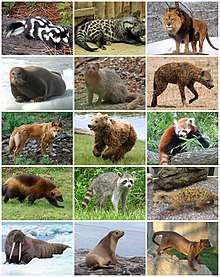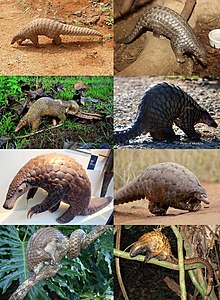Ferae
Ferae (/ˈfɪəriː/ FEER-ee, Latin: [ˈfɛrae̯]) is a clade of mammals, consisting of the orders Carnivora (wolves, cats, seals, and so on ; over 260 species around the globe) and Pholidota (eight species of pangolins in tropical Africa and Asia). An alternate name, Ostentoria, has also been proposed for a grouping of the Carnivora and Pholidota.[4] The last common ancestor of extant Ferae is supposed to have diversified ca. 78.9 million years ago.[1] Several extinct orders, relatives of the Pholidota, such as Creodonts,[3] are members of Ferae as well.
| Ferae | |
|---|---|
 | |
| High diversity of carnivorans | |
 | |
| Low species diversity in Pholidotes | |
| Scientific classification | |
| Kingdom: | Animalia |
| Phylum: | Chordata |
| Class: | Mammalia |
| Clade: | Ferungulata |
| Clade: | Ferae Linnaeus, 1758[2] |
| Subgroups | |
|
Possible members:[3]
| |
Phylogeny of extant taxa
Position of pangolins
Pangolins were long thought to be the closest relatives of Xenarthra (armadillos, anteaters, and sloths), contributing to the polyphyletic group of Edentata. Research based on immunodiffusion technique[5] and comparison of protein and DNA sequences[6][7][8] revealed the close relationships between pangolins and carnivorans. Living pangolins and carnivorans also share few unusual derived morphological and anatomical traits, such as the ossified tentorium cerebelli and the fusion of the scaphoid and lunate bones in the wrist.[9]
Sister groups to Ferae
According to recent studies (reflected in the diagram below), the closest relatives of Ferae are Perissodactyla (horses, tapirs, and rhinos) and Cetartiodactyla (which combines Artiodactyla—camels, pigs, ruminants and hippos—with Cetacea—whales and dolphins).[10][11] An alternate phylogeny (less supported) holds that the closest relatives to the Ferae are the Perissodactyla and Chiroptera (bats), not Cetartiodactyla.[12] Ferae together with Perissodactyla has been called Zooamata. Ferae, Perissodactyla, and Chiroptera together has been called Pegasoferae.
| Phylogenetic position of the Ferae in the context of the order-level cladogram of Boreoeutheria. | |||||||||||||||||||||||||||||||||||||||
| |||||||||||||||||||||||||||||||||||||||
| The cladogram has been reconstructed from mitochondrial and nuclear DNA and protein characters. |
Fossil members
Position of Creodonta
Various enigmatic Palaeocene mammals have been found to belong to Ferae. While there has been strong support in the inclusion of creodonts into Ferae, they were usually recovered as sister taxon to Carnivoramorpha (carnivorans and their stem-relatives).[13] The phylogenetic analysis of hundreds of morphological characters of Paleocene placentals found instead that creodonts might be the sister group to Pholidotamorpha (pangolins and their stem-relatives).[3]
| Phylogenetic position of Creodonta within Ferae.[14][15] | ||||||||||||||||||||||||||||||||||||||||||||||||||||||||||||||||||||||||||
|
Possible members
In addition various supposedly "hoofed mammals" like the mesonychians and arctocyonids (usually considered as stem-artiodactyls[16]) also belong to the group. In addition, Mesonychians might be the sister group to carnivoramorphs, while arctocyonids are polyphyletic with Arctocyon and Loxolophus sister to pantodonts and periptychids, Goniacodon and Eoconodon sister to the Carnivoramorpha-Mesonychia clade, most other genera allied with creodonts and palaeoryctidans, and Protungulatum not a placental mammal.[3] This enlarged Ferae was also found to be the sister group to Chiroptera.[3]
Below is a phylogeny of the interrelationships within Ferae among the various extant and fossil groups, as well as their sister placement to Chiroptera after Halliday et al. (2015)[3]:
| ||||||||||||||||||||||||||||||||||||||||||||||||||||||||||||||||||||||||||||||||||||||||||||||||||||||||||||||||||||||||||||||||||||||||||||||||||||||||||
References
- Gaubert, Philippe; Antunes, Agostinho; Meng, Hao; Miao, Lin; Peigné, Stéphane; Justy, Fabienne; Njiokou, Flobert; Dufour, Sylvain; Danquah, Emmanuel; Alahakoon, Jayanthi; Verheyen, Erik (11 May 2018). "The Complete Phylogeny of Pangolins: Scaling Up Resources for the Molecular Tracing of the Most Trafficked Mammals on Earth". Journal of Heredity. 109 (4): 347–359. doi:10.1093/jhered/esx097. ISSN 0022-1503. PMID 29140441.
- "'Ferae' - The Linnean Collections". linnean-online.org. Retrieved 26 February 2020.
- Halliday, Thomas J. D.; Upchurch, Paul; Goswami, Anjali (2015). "Resolving the relationships of Paleocene placental mammals" (PDF). Biological Reviews. 92 (1): 521–550. doi:10.1111/brv.12242. ISSN 1464-7931. PMC 6849585. PMID 28075073.
- Amrine-Madsen, H.; Koepfli, K.P.; Wayne, R.K.; Springer, M.S. (2003). "A new phylogenetic marker, apolipoprotein B, provides compelling evidence for eutherian relationships". Molecular Phylogenetics and Evolution. 28 (2): 225–240. doi:10.1016/S1055-7903(03)00118-0. PMID 12878460.
- Shoshani, J. (1 May 1986). "Mammalian phylogeny: comparison of morphological and molecular results". Molecular Biology and Evolution. 3 (3): 222–242. doi:10.1093/oxfordjournals.molbev.a040389. ISSN 0737-4038.
- Shoshani, Jeheskel; Goodman, Morris; Czelusniak, John; Braunitzer, Gerhard (1985). Luckett, W. Patrick; Hartenberger, Jean-Louis (eds.). "A Phylogeny of Rodentia and Other Eutherian Orders: Parsimony Analysis Utilizing Amino Acid Sequences of Alpha and Beta Hemoglobin Chains". Evolutionary Relationships among Rodents. NATO Advanced Science Institutes (ASI) Series. Boston, MA: Springer US: 191–210. doi:10.1007/978-1-4899-0539-0_7. ISBN 978-1-4899-0539-0.
- Madsen, Ole; Scally, Mark; Douady, Christophe J.; Kao, Diana J.; DeBry, Ronald W.; Adkins, Ronald; Amrine, Heather M.; Stanhope, Michael J.; de Jong, Wilfried W.; Springer, Mark S. (2001). "Parallel adaptive radiations in two major clades of placental mammals". Nature. 409 (6820): 610–614. doi:10.1038/35054544. ISSN 1476-4687. PMID 11214318.
- Murphy WJ, Eizirik E, et al. (14 December 2001). "Resolution of the Early Placental Mammal Radiation Using Bayesian Phylogenetics". Science. 294 (5550): 2348–2351. Bibcode:2001Sci...294.2348M. doi:10.1126/science.1067179. PMID 11743200.
- Gaudin, Timothy J.; Gaubert, Philippe; Billet, Guillaume; Hautier, Lionel; Ferreira-Cardoso, Sérgio; Wible, John R. (1 January 2020), Challender, Daniel W. S.; Nash, Helen C.; Waterman, Carly (eds.), "Chapter 1 - Evolution and morphology", Pangolins, Biodiversity of World: Conservation from Genes to Landscapes, Academic Press, pp. 5–23, doi:10.1016/b978-0-12-815507-3.00001-0, ISBN 978-0-12-815507-3, retrieved 26 February 2020
- Beck, Robin MD; Bininda-Emonds, Olaf RP; Cardillo, Marcel; Liu, Fu-Guo; Purvis, Andy (13 November 2006). "A higher-level MRP supertree of placental mammals". BMC Evolutionary Biology. 6 (1): 93. doi:10.1186/1471-2148-6-93. PMC 1654192. PMID 17101039.
- Zhou, X.; et al. (2011). "Phylogenomic analysis resolves the interordinal relationships and rapid diversification of the Laurasiatherian mammals". Systematic Biology. 61 (1): 150–64. doi:10.1093/sysbio/syr089. PMC 3243735. PMID 21900649. Retrieved 3 October 2011. (Advance Access; published online 7 September 2011)
- Nishihara, H.; Hasegawa, M; Okada, N (2006). "Pegasoferae, an unexpected mammalian clade revealed by tracking ancient retroposon insertions". Proceedings of the National Academy of Sciences. 103 (26): 9929–34. Bibcode:2006PNAS..103.9929N. doi:10.1073/pnas.0603797103. PMC 1479866. PMID 16785431.
- McKenna, M. C. (1975). "Toward a phylogenetic classification of the Mammalia". In Luckett, W. P.; Szalay, F. S. (eds.). Phylogeny of the Primates. New York: Plenum. pp. 21–46.
- Solé, F. & Ladevèze, S. (2017). "Evolution of the hypercarnivorous dentition in mammals (Metatheria, Eutheria) and its bearing on the development of tribosphenic molars." Evolution & Development, 19(2), 56–68.
- Prevosti, F. J., & Forasiepi, A. M. (2018). "Introduction. Evolution of South American Mammalian Predators During the Cenozoic: Paleobiogeographic and Paleoenvironmental Contingencies"
- Smith, De Bast. "Reassessment of the Small 'Arctocyonid' Prolatidens waudruae from the Early Paleocene of Belgium, and Its Phylogenetic Relationships with Ungulate-Like Mammals". Journal of Vertebrate Paleontology. doi:10.1080/039.033.0410 (inactive 22 January 2020). Retrieved 8 August 2013. Cite journal requires
|journal=(help)